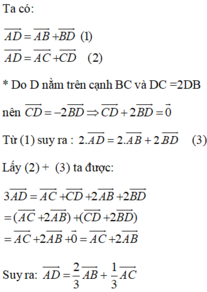Cho tam giác ABC, D là điểm thuộc cạnh BC sao cho DC= 2DB. Nếu \(\overrightarrow{AD}=m\overrightarrow{AB}+n\overrightarrow{AC}\) thì m và n bằng bao nhiêu?
Hãy nhập câu hỏi của bạn vào đây, nếu là tài khoản VIP, bạn sẽ được ưu tiên trả lời.


Câu 1:
ĐKXĐ:...
\(pt\Leftrightarrow\left(x-2\right)\left(x+1\right)\sqrt{x+1}=0\)
\(\Leftrightarrow\left[{}\begin{matrix}x=2\\x=-1\end{matrix}\right.\) (t/m)
Câu 2:
\(\overrightarrow{AB}+\overrightarrow{BD}=m\overrightarrow{AB}+n\overrightarrow{AC}\)
Có \(\overrightarrow{DC}=2\overrightarrow{BD}\Rightarrow\overrightarrow{DB}+\overrightarrow{BC}=2\overrightarrow{BD}\Leftrightarrow3\overrightarrow{BD}=\overrightarrow{BC}\)
Có \(\overrightarrow{BC}=\overrightarrow{BA}+\overrightarrow{AC}\Rightarrow\overrightarrow{BD}=\frac{1}{3}\overrightarrow{BA}+\frac{1}{3}\overrightarrow{AC}\)
\(\Rightarrow\overrightarrow{AD}=\overrightarrow{AB}+\frac{1}{3}\overrightarrow{BA}+\frac{1}{3}\overrightarrow{AC}=\frac{2}{3}\overrightarrow{AB}+\frac{1}{3}\overrightarrow{AC}=m\overrightarrow{AB}+n\overrightarrow{AC}\)
\(\Rightarrow\left\{{}\begin{matrix}m=\frac{2}{3}\\n=\frac{1}{3}\end{matrix}\right.\)
Bài này thực chất là đi phân tích vt AD thành vt AB và AC thôi

\(\overrightarrow{CN}=2\overrightarrow{NA}\Leftrightarrow\overrightarrow{CA}+\overrightarrow{AN}=-2\overrightarrow{AN}\Leftrightarrow\overrightarrow{AN}=\frac{1}{3}\overrightarrow{AC}\)
\(\overrightarrow{AK}=\frac{1}{2}\overrightarrow{AM}+\frac{1}{2}\overrightarrow{AN}=\frac{1}{4}\overrightarrow{AB}+\frac{1}{6}\overrightarrow{AC}\Rightarrow\overrightarrow{KA}=-\frac{1}{4}\overrightarrow{AB}-\frac{1}{6}\overrightarrow{AC}\)
\(\overrightarrow{KD}=\overrightarrow{KA}+\overrightarrow{AD}=\left(-\frac{1}{4}\overrightarrow{AB}-\frac{1}{6}\overrightarrow{AC}\right)+\left(\frac{1}{2}\overrightarrow{AB}+\frac{1}{2}\overrightarrow{AC}\right)\)
\(=\frac{1}{4}\overrightarrow{AB}+\frac{1}{3}\overrightarrow{AC}\Rightarrow\left\{{}\begin{matrix}m=\frac{1}{4}\\n=\frac{1}{3}\end{matrix}\right.\) \(\Rightarrow m-n=-\frac{1}{12}\)

\(\overrightarrow{MB}=-2\overrightarrow{MC}\Leftrightarrow\overrightarrow{MB}=-2\left(\overrightarrow{MB}+\overrightarrow{BC}\right)\)
\(\Rightarrow3\overrightarrow{MB}=-2\overrightarrow{BC}\Rightarrow\overrightarrow{BM}=\frac{2}{3}\overrightarrow{BC}=\frac{2}{3}\left(\overrightarrow{BA}+\overrightarrow{AC}\right)=-\frac{2}{3}\overrightarrow{AB}+\frac{2}{3}\overrightarrow{AC}\)
\(\overrightarrow{AM}=\overrightarrow{AB}+\overrightarrow{BM}=\overrightarrow{AB}-\frac{2}{3}\overrightarrow{AB}+\frac{2}{3}\overrightarrow{AC}=\frac{1}{3}\overrightarrow{AB}+\frac{2}{3}\overrightarrow{AC}\)
\(\Rightarrow\left\{{}\begin{matrix}m=\frac{1}{3}\\n=\frac{2}{3}\end{matrix}\right.\) \(\Rightarrow mn=\frac{2}{9}\)

Ta có:
\(\vec{AN}=\vec{AM}+\vec{MN}\)
\(=\dfrac{2}{3}\vec{AC}+\dfrac{1}{4}\vec{MB}\)
\(=\dfrac{2}{3}\vec{AC}+\dfrac{1}{4}\left(\vec{AB}-\vec{AM}\right)\)
\(=\dfrac{1}{4}\vec{AB}+\dfrac{1}{2}\vec{AC}\)
\(\vec{AP}=\vec{AC}+\vec{CP}\)
\(=\vec{AC}+\dfrac{1}{k+1}\vec{CB}\)
\(=\vec{AC}+\dfrac{1}{k+1}\left(\vec{AB}-\vec{AC}\right)\)
\(=\dfrac{1}{k+1}\vec{AB}+\dfrac{k}{k+1}\vec{AC}\)
A, N, P thẳng hàng khi:
\(\dfrac{\dfrac{k}{k+1}}{\dfrac{1}{k+1}}=\dfrac{\dfrac{1}{2}}{\dfrac{1}{4}}\Leftrightarrow k=2\)
Kết luận: \(k=2\)

a) Có \(\overrightarrow{BC}^2=\left(\overrightarrow{AC}-\overrightarrow{AB}\right)^2=\overrightarrow{AC}^2+\overrightarrow{AB}^2-2\overrightarrow{AC}.\overrightarrow{AB}\)
Suy ra: \(\overrightarrow{AC}.\overrightarrow{AB}=\dfrac{\overrightarrow{AC^2}+\overrightarrow{AB}^2-\overrightarrow{BC}^2}{2}=\dfrac{8^2+6^2-11^2}{2}=-\dfrac{21}{2}\).
Do \(\overrightarrow{AC}.\overrightarrow{AB}< 0\) nên \(cos\widehat{BAC}< 0\) suy ra góc A là góc tù.
b) Từ câu a suy ra: \(cos\widehat{BAC}=\dfrac{\overrightarrow{AB}.\overrightarrow{AC}}{\left|\overrightarrow{AB}\right|.\left|\overrightarrow{AC}\right|}=-\dfrac{21}{2.6.8}=-\dfrac{7}{32}\).
Do N là trung điểm của AC nên \(AN=AC:2=8:2=4cm\).
\(\overrightarrow{AM}.\overrightarrow{AN}=AM.AN.cos\left(\overrightarrow{AM},\overrightarrow{AN}\right)\)
\(=2.4.cos\left(\overrightarrow{AB},\overrightarrow{AC}\right)=2.4.\dfrac{-7}{32}=-\dfrac{7}{4}\).



Ta có \(\overrightarrow{AD}=\overrightarrow{AC}+\overrightarrow{CD}=\overrightarrow{AC}+2\overrightarrow{CB}=\overrightarrow{AC}+2\left(\overrightarrow{CA}+\overrightarrow{AB}\right)=\overrightarrow{AC}-2\overrightarrow{AC}+2\overrightarrow{AB}\)
\(=2\overrightarrow{AB}-\overrightarrow{AC}\)
Vậy m = 2 , n = -1